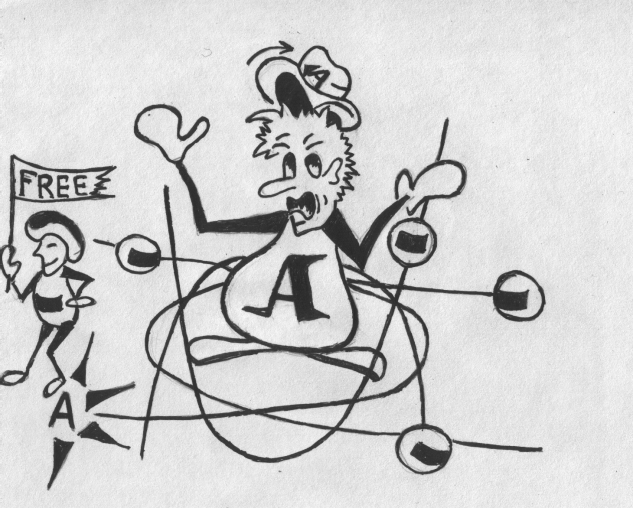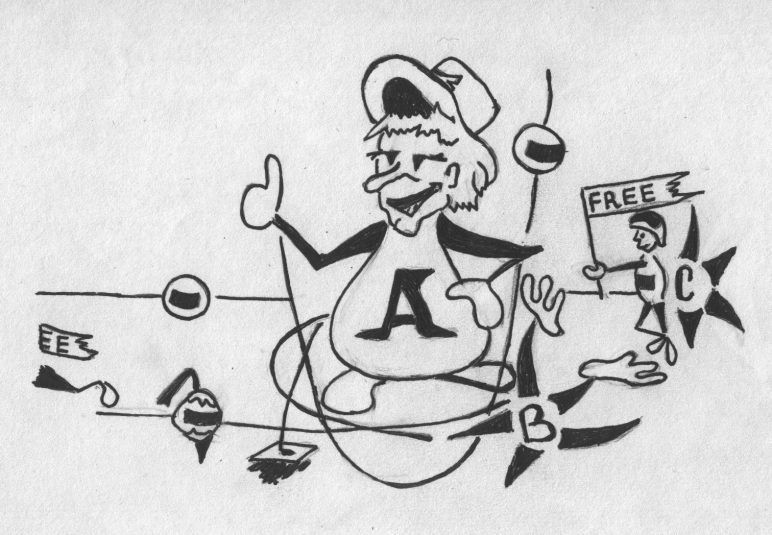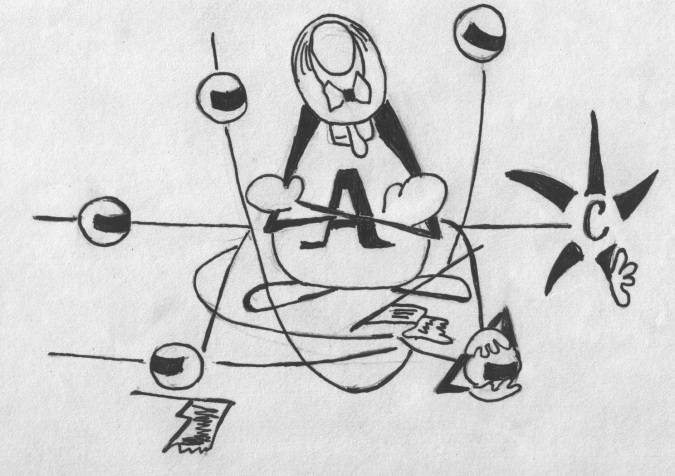
- •Negative (with no auxiliary verb)
- •Questions (with the auxiliary verb)
- •Questions (with no auxiliary verb)
- •Read and translate the following international words:
- •Consult the table above and write full sentences. Use is/are. Where possible change sentences to use isn’t/aren’t.
- •Complete the sentences using the following verbs: emit(s), occur(s), flow(s), define(s), repel(s), attract(s), have(has).
- •Put the verb in brackets into the correct form. Insert always/never/
- •Mind the word-order and compile sentences from the following words:
- •Put questions to the following sentences:
- •Form nouns from the following verbs using the suffix –tion and translate them:
- •Guess the meaning of the following adjectives paying attention to the suffix – ic:
- •Read and translate word-combinations
- •Choose as many words from the table оf ex. 1 as you can and form sensible sentences in Present Simple (affirmative, negative and interrogative).
- •Specialist reading
- •Mark the following sentences as true (t) or false (f). Then read the text “Diodes” and check yourself.
- •Read the text again and complete the sentences with the correct ending.
- •Work in pairs. Ask your partner questions based on the text. Make sure you use correct auxiliary verb.
- •Speaking
- •In Russian write a content-based summary of the text you have translated.
- •Make a reverse written translation (from Russian into English) of your summary.
- •Find more information about conduction of current in a semiconductor diode and tell your group mates.
- •Negative
- •Adjectives and adverbs
- •Degrees of Comparison
- •Fill in the table.
- •Put the verb in brackets into the correct form, Present Continuous or Present Simple.
- •Choose the appropriate English equivalents:
- •Translate the following sentences. Mind the meaning of the highlighted words.
- •Choose as many words from the table оf ex. 1 as you can and form sensible sentences in Present Continuous (affirmative, negative and interrogative).
- •Specialist reading
- •Read the text “Triodes” and choose its best summary.
- •15. Read the text again and complete the sentences.
- •Speaking
- •Forms of the Personal Pronouns and One
- •Fill in the table.
- •Read and translate the following international words:
- •Choose the appropriate English equivalents. What do all of them have in common?
- •Translate starting from the first component:
- •Give the three forms of the following irregular verbs.
- •Choose the appropriate English equivalents:
- •Choose the appropriate Russian equivalents to Participles II:
- •Do not translate! Define where the subject is the doer of the action.
- •Translate paying attention to the Passive Voice.
- •Make up sentences from the following words. Put a in the Present Simple Passive, b – in the Present Continuous Passive.
- •Make questions to match the answers. All of them are in the Passive Voice.
- •Match the following sentences with their translations. Which of them are in Passive?
- •Choose as many words from the table оf ex. 1 as you can and form sensible sentences in Present Simple Passive and Present Continuous Passive (affirmative, negative and interrogative).
- •Match the terms in Table a with their definitions in Table b
- •Translate paying attention to the meanings of the word one.
- •Change the form of the personal pronouns given in brackets.
- •Make up sentences with personal pronouns on the topic of electronics and physics. Specialist reading
- •Read the text again and complete the sentences with the correct beginning or ending.
- •Work in pairs. Ask your partner questions based on the text. Make sure you use correct auxiliary verb.
- •Speaking
- •Conductivity
- •In Russian write a content-based summary of the text you have translated.
- •Make a reverse written translation (from Russian into English) of your summary.
- •Find more information about classification of materials based on other principles and tell your group mates.
- •Negative (with the auxiliary verb)
- •Negative (with no auxiliary verb)
- •Questions (with the auxiliary verb)
- •Questions (with no auxiliary verb)
- •1. Fill in the table.
- •4. Put in the missing words, using the words from the previous units and the table above.
- •5. Put all possible questions to the following statements.
- •6. Put the verb in brackets into the Past Simple.
- •7. Form nouns from the following adjectives using the suffix -ity and translate them:
- •8. Choose the appropriate English equivalents:
- •11. Match the following word-combinations with their translations.
- •12. Match the following sentences with their translations.
- •13. Choose as many words from the table оf ex. 1 as you can and form sensible sentences in Past Simple (affirmative, negative and interrogative).
- •Specialist reading
- •Matter, Elements and Atoms
- •Read the text again and complete the sentences.
- •16. Match the terms in Table a with their definitions in Table b.
- •Speaking
- •18. You are taking your exam in Physics. Your examination card says: Matter, its definition and basic notions. Your partner is your examiner. Answer his questions and try to get a good mark.
- •19. Divide into 2 groups. Group 1 translates Extract a and group 2 – extract b of the text “Electricity” with a dictionary in writing, paying attention to the use of the Past Simple.
- •3. Read the dialogue and learn how to speak about your past activities. Put the verb in brackets into the Past Continuous. Pay attention to the terms of electricity.
- •4. Put in the missing words, using the words from the table above:
- •5. Put all possible questions to the following statements.
- •6. Put the verb in brackets into the Past Continuous.
- •7. Form nouns from the following verbs using the suffix -ment and translate them:
- •8. Choose the appropriate English equivalents.
- •9. Translate the text. Use a dictionary if necessary. To each sentence put different type of question in Present Continuous.
- •11. Match the following word-combinations with their translation.
- •12. Match the following sentences with their translation.
- •13. Choose as many words as you can of ex.1 and form sensible sentences.
- •Specialist reading
- •14. Read the text “Covalent Bonds” only once. How much can you remember? Answer these questions without additional reading.
- •If you failed try to answer these questions again after doing the exercises given below the text.
- •15. Read the text again and complete the sentences.
- •16. Study the text and translate the following:
- •17. Match the terms in Table a with their definitions in Table b.
- •Speaking
- •18. Summarize the text “Covalent Bonds” in 150 words.
- •19. In pairs ask and answer text-based questions.
- •20. Divide into 2 groups. Group 1 translates Extract a and group 2 – extract b of the text “Semiconductors” with a dictionary in writing.
- •Past Continuous Passive Affirmative
- •Negative
- •1. Fill in the table.
- •2. Read and translate the following international words:
- •3. Put in the missing words, using the words from the table above:
- •4. Put all possible questions to the following statements.
- •5. Put the verb in brackets into the Past Simple Passive.
- •6. Change the following sentences so as to use the Past Simple Passive.
- •7. Form nouns from the following verbs and translate them:
- •9. Match the following words and phrases with their translation.
- •10. Choose the nouns from the following words.
- •11. Match the following expressions with their translation:
- •12. Choose as many words from the table оf ex. 1 as you can and form sensible sentences in Past Simple Passive or Past Continuous Passive (affirmative, negative and interrogative).
- •Specialist reading
- •13. Read the text “Electrons and Holes” only once. How much can you remember? Answer these questions without additional reading.
- •If you failed try to answer these questions again after doing the exercises given below the text.
- •14. Read the text again and complete the sentences.
- •15. Match the terms in Table a with their definitions in Table b.
- •Speaking
- •17. In pairs ask and answer text-based questions.
- •18. Divide into 2 groups. Group 1 translates Extract a and group 2 – Extract b of the text “Supernovae” with a dictionary in writing.
- •Unit VII
- •Language Work Present Perfect Active (I have patented)
- •Present Perfect Passive (measurements have been done)
- •Fill in the table.
- •Fill in the gaps using the following verbs: break, free, move, come, occur, appear.
- •Make up sentences using Present Perfect. Use the prompts in brackets. Mind the position of just/already/yet.
- •Open the brackets and complete the dialogues with just, already, yet. Use Passive Voice where nessesary.
- •You are asking students questions about things they have done. Make questions with ever using the words in brackets.
- •Read the situations and write sentences using the example.
- •Rewrite these sentences into Passive Voice.
- •Make sentences from the words in brackets using the Present Perfect Passive.
- •Form adjectives from the following nouns using the suffix -ous and translate them.
- •Read and translate word-combinations.
- •Match the following sentences with their translations.
- •Choose as many words from the table of ex.1 as you can and form sensible sentences.
- •Specialist reading
- •Read the text “The Movement of Holes”. Mark the following sentences as true (t) or false (f).
- •The Movement of Holes
- •Read the text again and complete the sentences with the correct ending.
- •Work in pairs. Ask your partner some questions based on the text. Make sure you use the correct auxiliary verb.
- •Speaking
- •Measuring the Movement of Holes in Crystal Surfaces
- •In Russian write a content-based summary of the text you have translated.
- •Make a reverse written translation (from Russian into English) of the text “Measuring the Movement of Holes in Crystal Surfaces”.
- •Serve as simultaneous interpreter. Make an oral reverse interpretation of the text. Unit VIII
- •Language Work Past Perfect Active (I had measured)
- •Past Perfect Passive (it had been measured) Affirmative
- •Questions
- •Open the brackets and put the verbs into the Past Perfect or Past Indefinite/Continuous Tense(Active or Passive).
- •Make the sentences of ex.2 negative and interrogative.
- •For each situation, write a sentence ending with never … before. Use the verbs in brackets.
- •Put the verb into the correct form, Past Perfect (I had measured) or Past Simple (I measured).
- •Complete these sentences with the following verbs (in the form of Past Perfect Passive):change, know, analyze, use, install.
- •Rewrite these sentences into Past Perfect Passive/Active.
- •Match the following sentences with their translations.
- •Specialist reading
- •Read the text “Silicon”. Find the answers to the following questions.
- •Silicon
- •Read the text again and select the best completion for each sentence. Complete the following sentences using the multiple choice suggested. There might be more than one variant.
- •Complete the sentences with the correct ending according to the text.
- •Speaking
- •Summarize the text “Silicon” in 150 words.
- •Translate the text “Applications of Silicon” paying attention to new technical terms in writing. Applications of Silicon
- •In Russian write a content-based summary of the text you have translated.
- •Make a reverse written translation (from Russian into English) of your summary.
- •Find more information about silicon applications and tell your group mates.
Fill in the gaps using the following verbs: break, free, move, come, occur, appear.
Fig. 1. A hole has appeared at point A |
- Figure 1 shows a part of a silicon crystal in which the breaking of covalent bonds is taking place.
|
- Will you be able to explain what is taking place in the next figure (Fig. 2)? - Yes, of course. A hole … at point B and now two electrons can move through the crystal. |
F |
Fig. 3. Hole A has disappeared and hole C has appeared |
- Look at Fig. 3. The second electron … close enough to the first hole and is attracted by its electric field. Recombination … . Now there is no hole already at point A. But still there is a hole at point B. It seems that the hple… from position A to position B. - Looking at this figure, it becomes clear that one more hole … at point C. |
|
Fig. 4. Hole B has disappeared |
Make up sentences using Present Perfect. Use the prompts in brackets. Mind the position of just/already/yet.
How have you decreased the capacitance of your system?
I have just connected equal capacitors in series.
(I/just/connect/equal/capacitors/in series)
Can we observe any changes in the movement of electrons and holes?
Of course, we can, but …
(only/when/process/of recombination/already/occur)
Could you stop the movement of holes quite fast?
No, …
(I/just/heat/a peace of silicon)
Have you already changed a random character of movement of holes in a piece of germanium?
Unfortunately …
(I/not/apply/any/voltage/yet)
Do you consider me an expert in a problem of the movement of holes?
No, …
(I/already/consider/a lot of/important/things/but not all)
Could you increase the amplification factor of our circuit?
Yes, …
(I/already/replace/a triode/for a tetrode)
Open the brackets and complete the dialogues with just, already, yet. Use Passive Voice where nessesary.
1. A: How do we call the phenomenon of attracting an electron by electric field?
B: Don’t you know that the scientists … (call) this process recombination?
A: I learned about the intrinsic conduction yesterday .
B: Yes, but you … (not/consider) in what types of materials it takes place.
A: Do we have a method to divide the flow of electrons and holes?
B: I … (do) this by means of applying voltage.
A: There is no sense to look for different ways of controlling the increase of temperature in a triode. How do you think, why?
B: I think, because a Centigrade scale … (invent).


 ig.2.
A hole has appeared at point B.
ig.2.
A hole has appeared at point B.
